|
Banjo ukuleles are very strange. They don't really sound like banjos and they don't sound like ukuleles. There are a variety of different types and each type souds different from the others. Banjo ukes were (and are) more popular in England than here in the US because of George Formby a big music hall and movie star who played one. (Our equivalent star was Ukulele Ike who played the usual mahogany-type uke.) In the US, the popularity of the banjo uke seems to have peaked in the thirties but is now having a revival. Ian Whitcomb seems to have recently switched frim his Martin uke to a rather impressive banjo ukulele which he plays with his band the Bungalo Boys at the Cicada Club. The banjo ukes (and other banjos) are so loud that it is often desirable to quieten them down. Metal mutes are availble that attach to the bridge and/or the inside can be loosely stuffed with rags or polyester pillow stuffing. Tuning the uke in a lower key will make it less loud and often sounds better than the regular tuning. The banjo ukes with the larger pots and heavy tension rings generally sound better than the smaller light-weight ones. Banjo players who sing generally place some kind of padding (such as old socks) behind and in contact with the vellum or plastic head to mute the sound. This generally improves the tone. Links to some banjo ukulele video clips are on the Links page of this website.
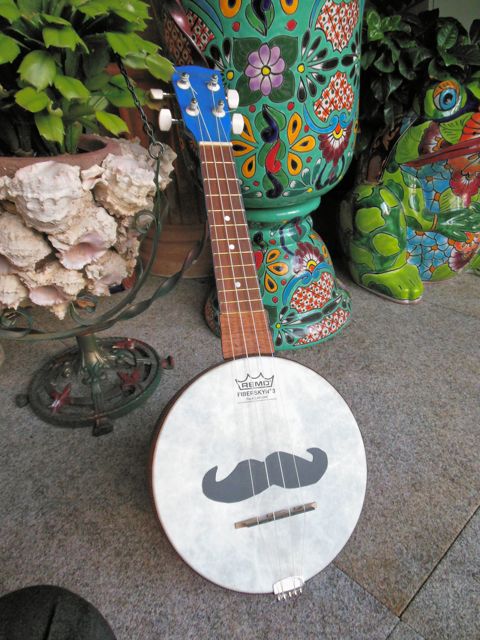
Shown above and below: Cheap homemade banjo uke made from a Remo hand drum and neck from a broken ukulele. Spacers must be used between the neck and the drum so that the 12th fret can be hailf way between the bridge and the nut. You can hear it played on youtube.com at cheap banjo uke 1
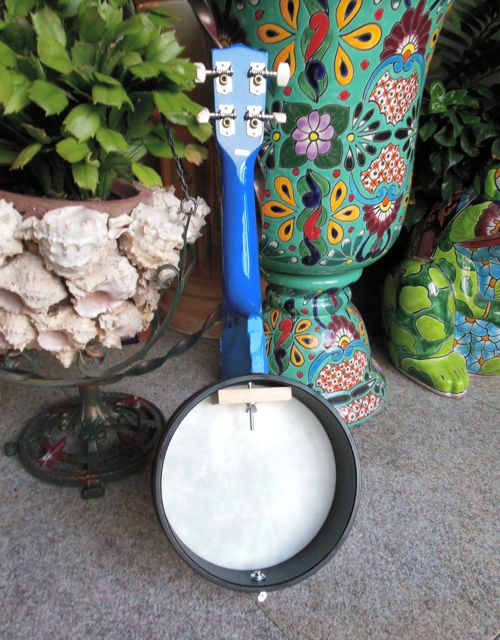
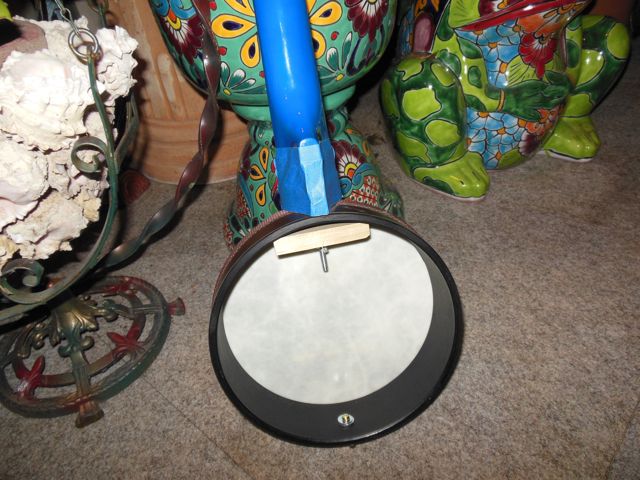
The above picture shows how the neck is attached to the drum with a hanger bolt which has machine screw threads on one end and wood screws on the other end with a wing nut to hold it all together. There are mahogany wood spacers glued to the neck so that the bridge can be placed as far from the 12th fret as the 12th fret is from the nut.
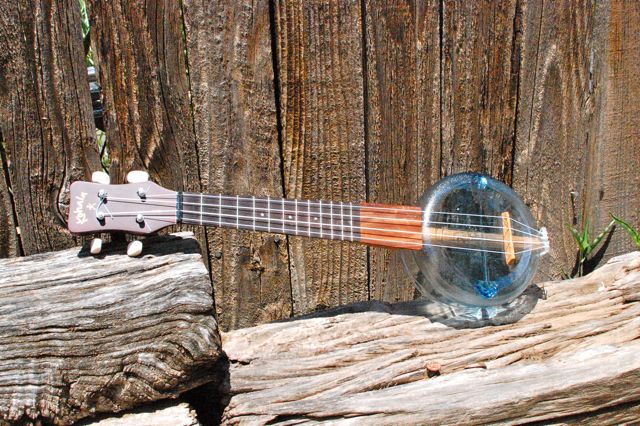
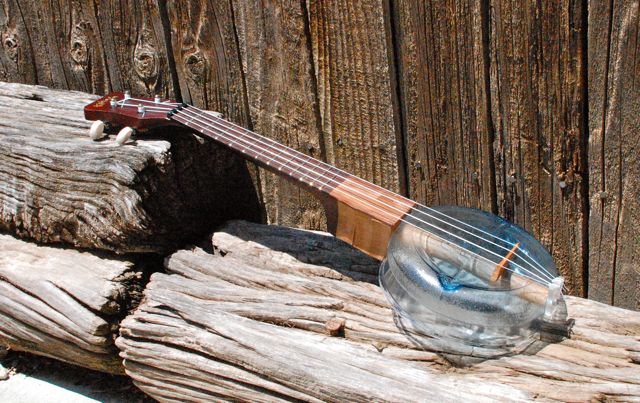

The pictures above show a ukulele made from the bottom of a plastic water bottle which was sawed off with a fine-saw Dremel tool. It fullfilled my plan to make a ukulele with a good tone that would not be very loud. You can hear me playing it on youtube.com listed as: cheap uke 1 and cheap uke a. The above shows how this cheap uke is made. The same construction technique can be used for making banjo ukuleles if you substitute a hand drum or cookie tin for the plastic jug bottom. The spacers of mahogany are glued to the neck and must take enough space so that the bridge can be placed as far from the 12th fret as the 12th fret is from the nut.The dowell stick is from oak and is attached to the neck with a 1/4" double ended screw about an inch long screwed into the neck with pliers. The dowell stick is screwed on from inside the bottle by twisting it tightly on to the screw.
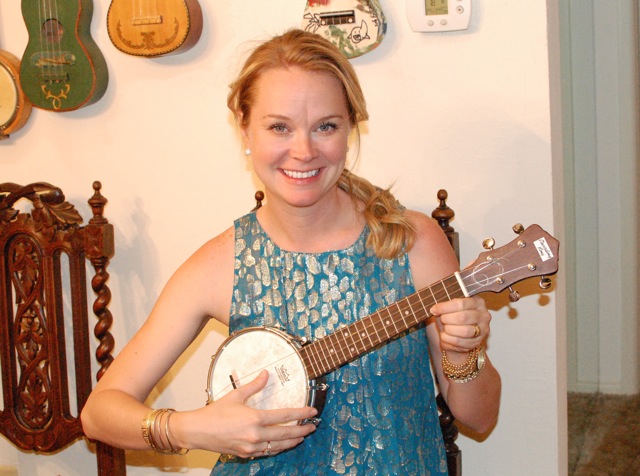
Great quality in a small package--including the uke: the Recording King 6" banjo ukulele, loud but with a good tone.
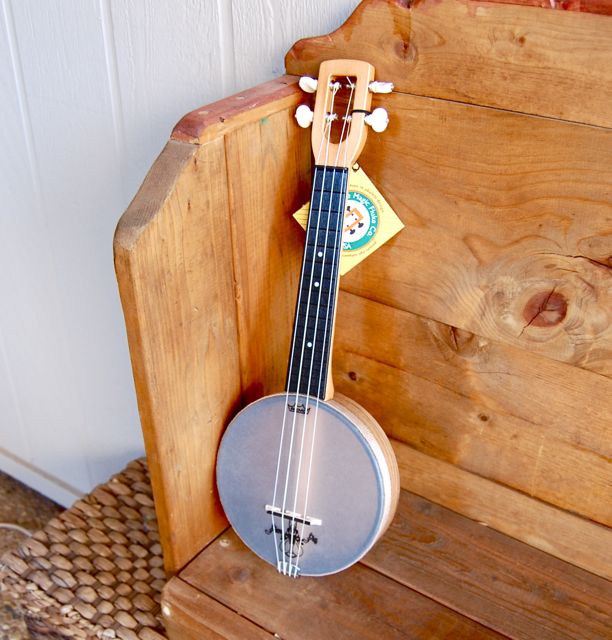
Shown above is the Firefly banjo ukulele made in the USA by the Magic Fluke Company. (Search for "Firefly") Its unique design deserves to be displayed in a museum of modern art. It is lightweight and very well made and has no annoying external lugs to catch on your clothes. The neck is fairly wide and thus easy for modern uke players to finger, but it sounds a lot like the classic banjo ukuleles of the 1920's. It is very loud (as are all banjo ukes) but the volume can be reduced by using the time-honored banjo technique of lightly wedging a sock between the dowel stick and the head. Below is a fancy version inspired by ukulele chanteuse Janet Klein with cartoon figures like the old-time Harold Teen ukulele. You can order one of these instant collectible from Janet Klein at Kleinette.com. The banjo ukulele is quite suitable for bluegrass songs if you can sing loud enough. Example: Cathy Hatch Firefly ukulele.
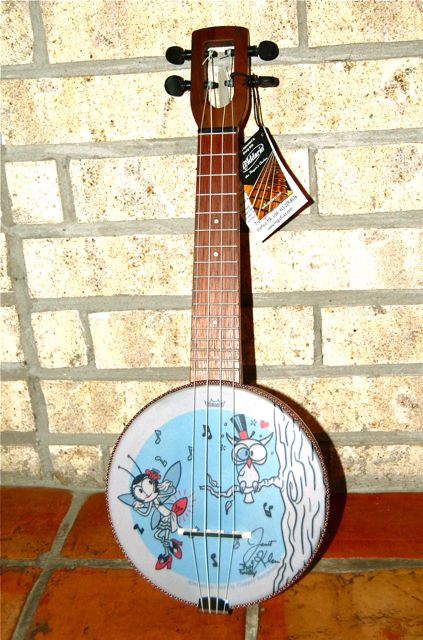
Shown above is the super fancy Janet Klein Firefly ukulele with cartoon like the old Harold Teen ukulele. This uke can be ordered with several options from Janet Klein at kleinette.com.
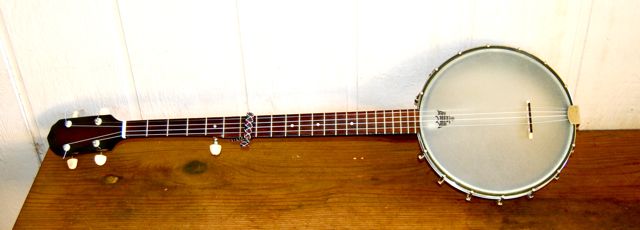
Shown above is a five string banjo that has been "ukefied", that is fixed so that you can use ukulele chords that you already know. This is done by taking off the short string and replacing the other strings with Aquila Classical banjo strings (which are nylon) and tuning the strings so they are one note lower than on a baritone ukulele: C F A D. (If you prefer metal strings for the true banjo sound. you can leave the original long strings and tune them C F A D) Then place a capo on whatever fret works for your song. The second fret will give you the notes on a baritone ukulele. If you place the capo behind the seventh fret you will have the notes that are on a regular ukulele. If the tuner for the short string gets in your way, take it off.
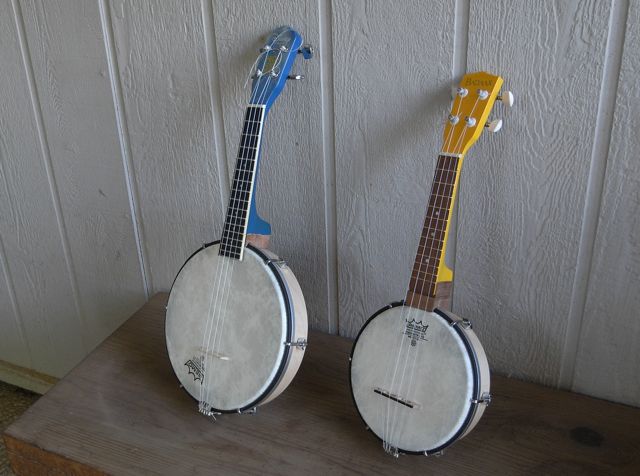
Shown here above are two home made banjo ukuleles made from Remo tunable hand drums. The Remo tunable hand drums are heavier and more sturdy than the nontunable ones. This gives them a better sound and lets you use heavier strings or metal strings. They have a heavy metal tension hoop which acts like the tone ring on a banjo. The one on the left has a 10 inch drum with the neck from a concert-size ukulele attached. I strung it with Martin Vega banjo strings for 5-string banjo (and discarded the short 5th string). The only way to have a concert size banjo uke with a 10 inch drum is to make it yourself, but the result is well worth the effort. I tuned it down a note to the key of Eb. When strummed, it sounds very much like the tenor banjo they have in a Dixieland band. The uke on the right is made from an 8 inch drum with the neck from a soprano ukulele. Notice that there are spacers placed next to the drums so that the bridges are not too close to the edge of the drum. The bridge must be placed so that the distance from the nut to the 12th fret equals the distance from the 12th fret to the bridge. These tunable drums are heavier and give a crisper sound than the non-tunable drums shown below. The 10 inch ukulele banjo has a more mellow than the 8 inch one. . If you want a more banjoesque sound, you can use steel strings made for a five-string banjo and tune it is the key of C like a regular ukulele. (Throw away the short 5th string.) When set up with steel strings the sound is loud. The 8 inch ukulele banjo on the right, when set up with Aquila Nylgut classical banjo strings is louder than the one made with the 8" non-tunable drum and sounds good tuned in the key of C. This link to "Whiskey in the Jar" shows a banjo ukulele that appears to have been made from an 8-inch tunable hand drum and you can judge how it sounds. The 10" tunable drum would work well for making a short-scale tenor banjo using a neck from a short-scale tenor banjo (which can usually be found on ebay.com, sold by someone who has converted a tenor banjo to a five-string banjo. Look below on this page for more about this.
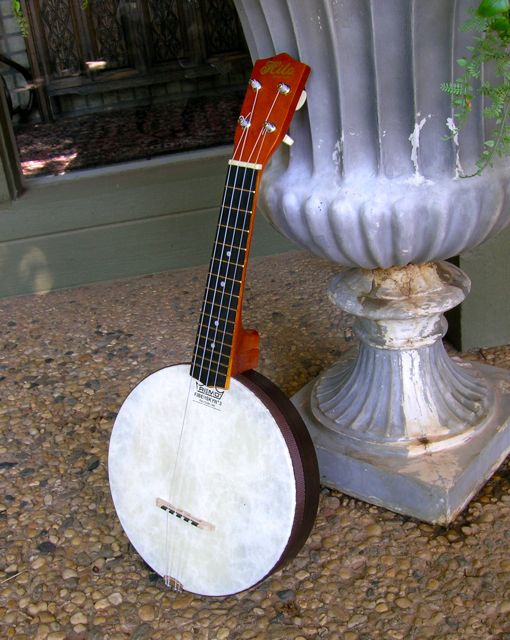
This is a banjo uke with a concert ukulele neck and made from a 10" by 2" Remo hand drum with a 7/8 inch spacer between the neck and the drum. The strings are the Aquila nylgut classical banjo strings. It has some 1" thick poly foam behind the head which smoothes the sound making it sound more mellow. This banjo uke is easy to make because it does not require a thick spacer and the spacer does not need a deep groove such as required if a tunable drum is used. Because of its size this uke is easy to play and pleasant to hold. The ten- inch drum gives it a more mellow sound than is the case when an 8" drum is used. There is no ready-made 10 inch-diameter concert-scale banjo uke that I know of.
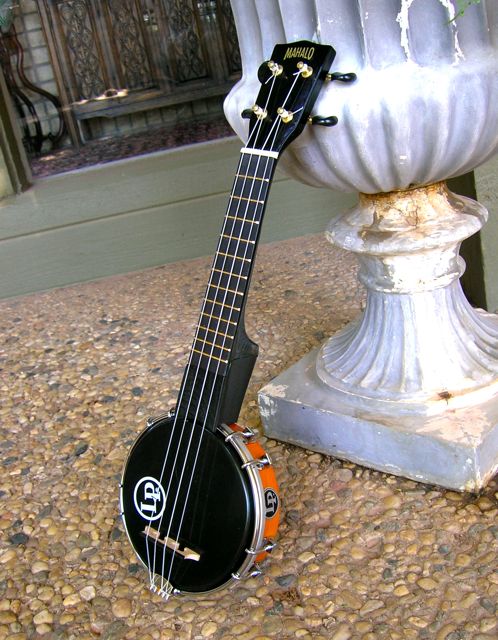
This is tambourim ukulele. The tambourim is a Brazilian hand drum about 6" in diameter which required a two and one half ince spacer between the neck and the drum. This uke banjo is very loud with a harsh sound. It is strung with Aquila Nylgut banjo ukulele strings. The neck of this uke is bolted to the drum with a threaded rod cut to the right length. Here is a clip of a tamborin ukulele banjo and another clip.
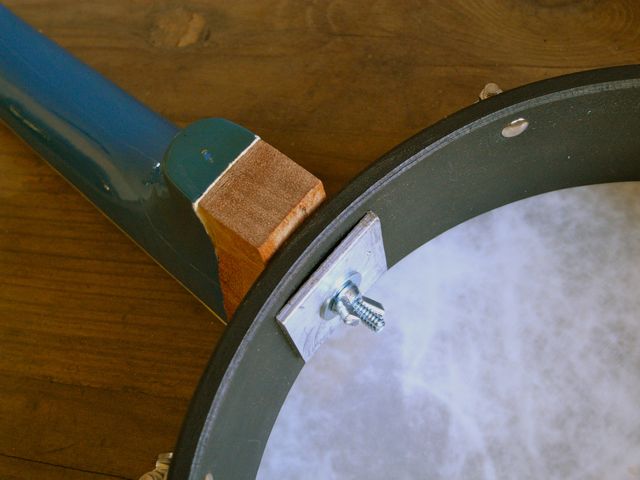
The above picture shows how the neck from a ukulele is attached to a hand drum. A hanger bolt is used to make it easy to remove the neck for adjusting the angle between the neck and the drum so that the action will be proper. A hanger bolt is a bolt that has machine screw threads on one end and wood screw threads on the other end which can be scewed into the neck. The wood spacer has a groove cut into it to allow for the tension ring. The width of the spacer is selected to place the bridge in a proper place.
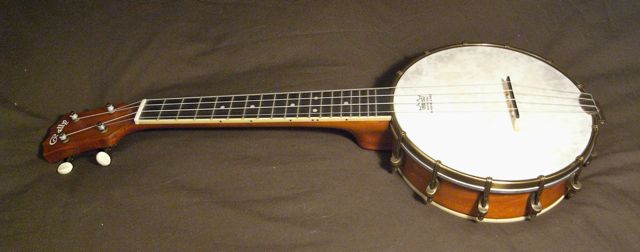 Shown here is a Rally banjo uke which is available by direct shipment from asia if you buy it on ebay. This ukulele is made with a concert-sized neck which gives you more room for you fingers. It is heavy which is usually the case for better-sounding banjos of all sizes. This partly due to having a heavy metal "tone ring" around the top of the ukulele another characteristic of quality banjos. The head is Remo fiberskin, a type of plastic instead of vellum which is found on the vintage ukuleles. The 8" diameter head with the heavy tension ring results in excellent tone and volume. This ukulele has more of the sound of a large banjo than most ukulele banjos. Here is a video clip of a banjo ukulele similar to this one playing "Bourbon Street Parade" and "banjo ukulele medly. Shown here is a Rally banjo uke which is available by direct shipment from asia if you buy it on ebay. This ukulele is made with a concert-sized neck which gives you more room for you fingers. It is heavy which is usually the case for better-sounding banjos of all sizes. This partly due to having a heavy metal "tone ring" around the top of the ukulele another characteristic of quality banjos. The head is Remo fiberskin, a type of plastic instead of vellum which is found on the vintage ukuleles. The 8" diameter head with the heavy tension ring results in excellent tone and volume. This ukulele has more of the sound of a large banjo than most ukulele banjos. Here is a video clip of a banjo ukulele similar to this one playing "Bourbon Street Parade" and "banjo ukulele medly.
Shown below is a homemade hand drum banjo ukulele using a $20.00 Remo 8" hand drum for the pot.
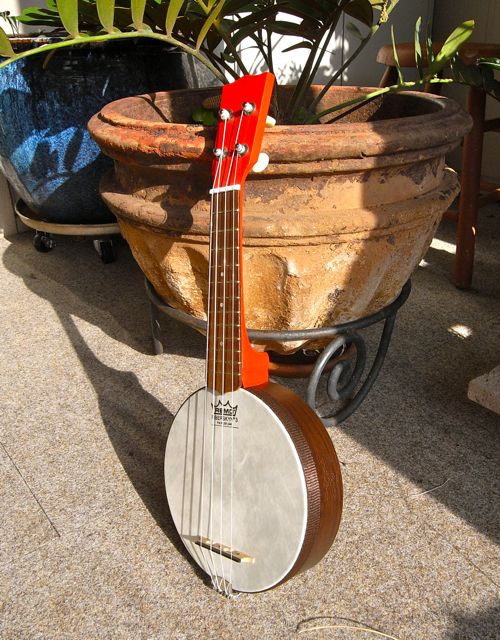
Here is a home-made banjo uke made from an 8 inch REMO Fiberskyn 3 hand drum that sells for under $20.00 together with some old ukulele and banjo parts. I found the drum on amazon.com. Because this is not a very robust method of attaching the neck, I recommend tuning the uke one full note below the usual C tuning so that the 3rd string is Bb. The uke should be tuned F, Bb, D. G going from the 4th string to the 1st string and will sound good even if it is tuned a half step lower than this. If you wish to tune the uke up to pitch in the key of C use the Aquila Nylgut classical bano strings and discard the short 5th string. This set up will give you a low G string whis is better for playing melodies. Here is a recording of this uke playing "Whispering". Assembly time is about two hours if you are handy with tools. If you aren't handy get someone who is to put the uke together. The tailpiece is available from amazon.com also. Recently I made a larger version of this instrument using a 10-inch drum and the neck from a concert-size ukulele. This makes a very practical and pleasant-sounding instrument. This type of hand drum results in a light weight ukulele which would be nice for young players; new banjo ukuleles are quite heavy as this gives a louder and snappier tone,
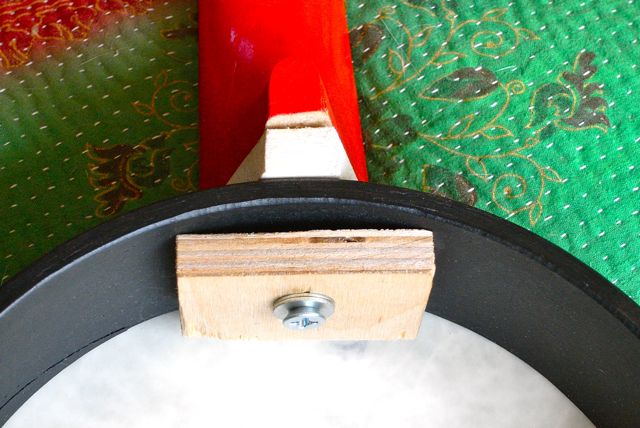
This shows the how to attach the neck to the drum using a piece of wood and a 2 1/2" long metal screw, diameter size 12. Since I took this picture I have determined that using a hanger bolt and wingnut is better than a screw since it is more secure and also easier to take apart. A hanger bolt has a wood-screw thread on one end and a machine-screw thread on the other end. You can see the use of a hanger bolt and wingnut on the home-made tenor banjo pictured below.
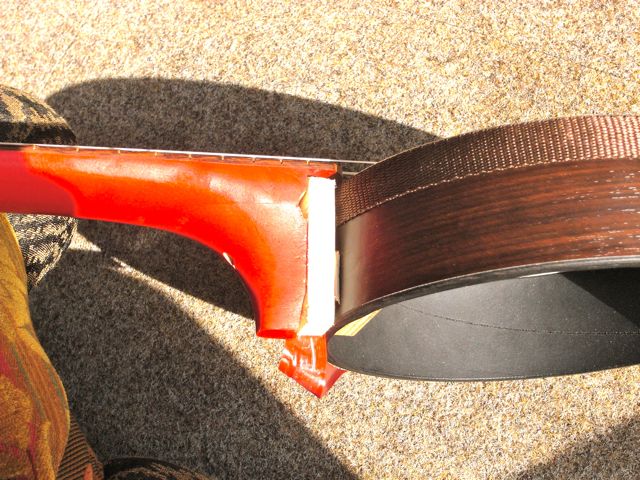
This shows a 3/8" spacer inserted between the neck and the drum so the bridge won't be too close to the rim. (The bridge must be placed so that the 12th fret is half the distance from the nut to the bridge.) The spacer will not be required if you use a banjo ukulele neck since it will be longer than the neck from a regular ukulele. Thin strips of wood can be used as shims to properly align the neck. Since I took this picture I have determined that the wood spacer between the neck and the drum should be one and one/half inches so that the bridge will not be too close to the edgeof the drum.
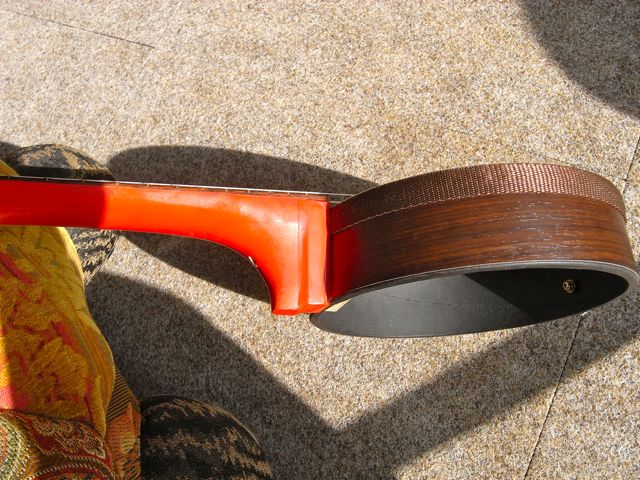
This shows the uke after the spacer is covered with red tape. The sound of this uke can be described as "great" or at least "good."
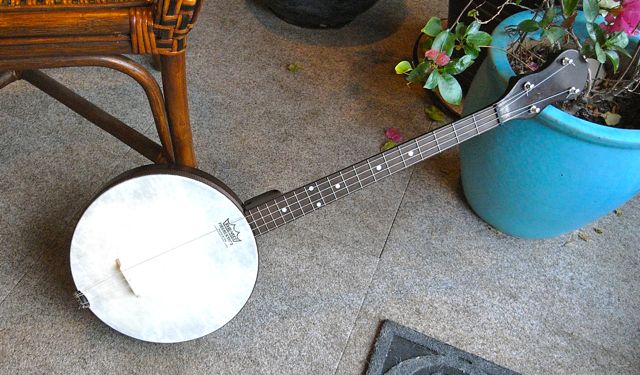
The above picture shows a home-made tenor banjo made by attaching the neck from a tenor banjo to a 10" diameter hand drum. The neck is a short-scale tenor banjo neck. If you use a longer neck you will have to attach it to a larger diameter hand drum. The distance from the nut to the 12th fret must be equal to the distance from the 12th fret to the bridge. This banjo is tuned like a baritone ukulele DGBE which is the same as the highest 4 strings of a guitar. (When a banjo is tuned like this it is called the "Chicago tuning") The strings are the Nylgut "Classic" banjo strings (without the fifth string). These strings are plastic so you can play them without a pick just like you play your ukulele and you can use all your familiar ukulele chords but you will be playing in a key that is 5 half steps lower. You can also use the guitar chord diagrams on the sheet music and leave off the lowest two strings. There seems to be quite a number of inexpensive tenor-banjo necks available on ebay.com, probably because people are putting 5-string banjo necks on the old tenor banjos and selling the 4-string tenor banjo neck. You will get a better louder sound if you use a tunable hand drum as shown in the picture above with the neck from a concert ukulele. If you plan to tune this instrument like a baritone ukulele (which is what I recommend) you should use the strings made for a 5-string banjo (and discard the short 5th string.) You may use either steel, nylon or gut strings.
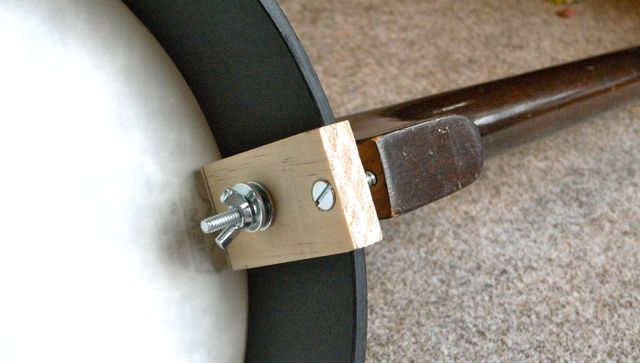
This picture shows how to attach the neck to the drum by using a hanger bolt and wingnut.
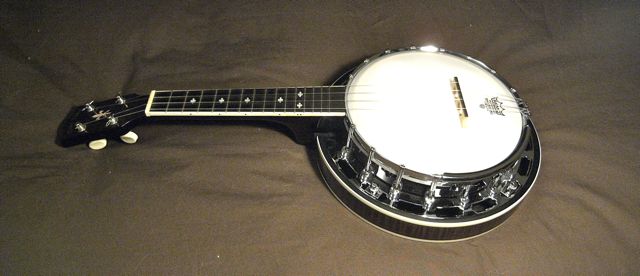 This is the Gold Tone Delux banjolele (banjo ukulele) similar to instruments played by English music hall stars George Formby and Tessie O'shea. This ukulele is heavy and weighs over 4lb 4oz, more than twice as much as the May Bell Concertone ukulele banjo. The weight is partly due to having a thick heavy tension hoop and a thick heavy tone ring which causes a bump near the edge under the head. This uke is extremely loud and sounds better to me when a one inch thick disk of pillow foam is placed inside under the head. The neck is moderately wide which makes it easy to play. You can hear Ian Whitcomb playing a uke sort of like this on the November 27, 2011 show on clubcicada.com. The heavy tension hoop and tone ring are usually found on higher priced full size banjos and result in a louder and clearer sound. I recently replaced the head on this instrument with one made of natural calfskin vellum which improved the sound and I also replaced the original strings with Aquila Nylgut Classic banjo strings which make the G string an octave lower for playing melodies and which have a more banjo-like sound. With these modifications, this uke is one of the the best sounding of the banjo ukuleles shown here. (And also the most expensive.) For more discussion concerning natural skin heads on this ukulele read the notes following this video. There are instructions for replacing a banjo ukulele head with one of natural vellum on the Repair Gallery page of this website. This is the Gold Tone Delux banjolele (banjo ukulele) similar to instruments played by English music hall stars George Formby and Tessie O'shea. This ukulele is heavy and weighs over 4lb 4oz, more than twice as much as the May Bell Concertone ukulele banjo. The weight is partly due to having a thick heavy tension hoop and a thick heavy tone ring which causes a bump near the edge under the head. This uke is extremely loud and sounds better to me when a one inch thick disk of pillow foam is placed inside under the head. The neck is moderately wide which makes it easy to play. You can hear Ian Whitcomb playing a uke sort of like this on the November 27, 2011 show on clubcicada.com. The heavy tension hoop and tone ring are usually found on higher priced full size banjos and result in a louder and clearer sound. I recently replaced the head on this instrument with one made of natural calfskin vellum which improved the sound and I also replaced the original strings with Aquila Nylgut Classic banjo strings which make the G string an octave lower for playing melodies and which have a more banjo-like sound. With these modifications, this uke is one of the the best sounding of the banjo ukuleles shown here. (And also the most expensive.) For more discussion concerning natural skin heads on this ukulele read the notes following this video. There are instructions for replacing a banjo ukulele head with one of natural vellum on the Repair Gallery page of this website.
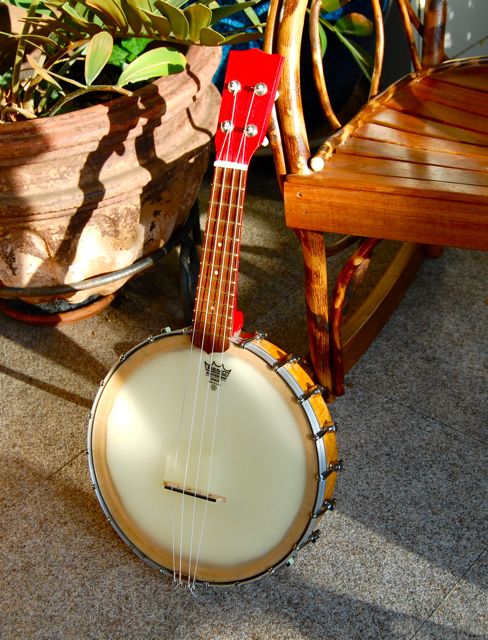
This uke was made by attaching the neck of a standard soprano ukulele to the 10 3/4'' pot of a regular size banjo. I thought this was an original idea until I saw an old one made this way on ebay.com. Anyway, it sounds great and is easy to play. It is strung with Aquila Nylgut classic banjo strings. The head is the Remo Renaissance head available from Elderly instruments (elderly.com). The hooks and lugs are available from ebay seller bezdez if you search under "guitar maker banjo hooks and lugs." The tension ring is made from a piece of aluminum 1/8" by 1/2" available at Lowe's and bent around the pot. The hooks and lugs keep it in place. There is an inch-thick piece of polyurethane foam under the head which damps the sound and smooths the tone. Set up this way this uke sounds excellent, loud with a good tone. Because banjos are basically bolted together, it is easy and practical to assemble one that fits your needs. The above instrument is tuned like a soprano ukulele with a low G string. By some twist of fate, the first, (highest) string is tuned to the same note (E) as the highest note on a tenor banjo so it should fit right in a trad jazz band and is much easier to finger when you are playing chords than is the a standard tenor banjo (which is tuned in 5ths).
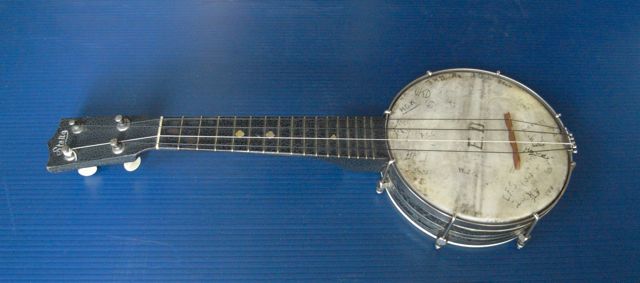
Shown above is a Stella banjo uke (banjolele). This uke has a 7" pot and sounds very good. It has a wide neck which is a major advantage over the May Bell Slingerland uke if you want to play the individual notes or don't have small hands. This same model was sold under various brands (as were just about all banjo ukes.)
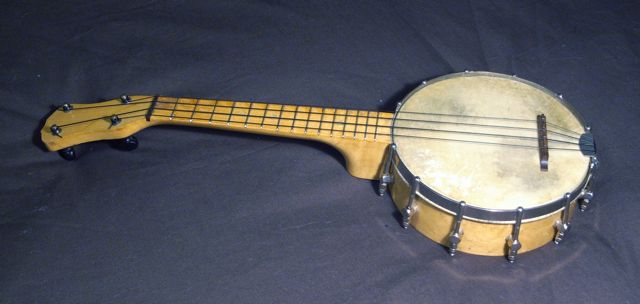
Shown here is one of the most commonly found vintage ukulele banjos, the Concertone banjo ukulele, made by Slingerland and virtually identical to the Slingerland May Bell banjo ukulele. It was sold sold under various other names also such as S S Stewart Collegian. This uke sounds very good for its size and weight. You can hear one in this video clip by Evans and Rogers. This ukulele is the same as the S S Stewart Collegian shown on the repair page except that one has a layer of dark wood over the fret board. These ukuleles usually sell on ebay for around $150.00 depending on their condition. A disadvantage of this uke is the narrow neck which was common on the banjo ukes but not on the standard ukes of the same era.
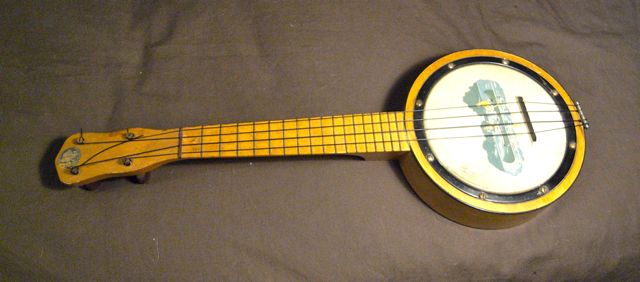
This type of banjo ukulele was one of the earliest designs. It was made with the back open or with an arched back with f holes. They usually do not have a tone ring and so are light weight. This uke is 7" wide but the head is only 5 1/5" diameter, which in my opinion is too small for optimal sound. They are apparently desirable to collectors because of their looks since they don't seem worth the prices if you want to play them instead of hanging them on the wall.
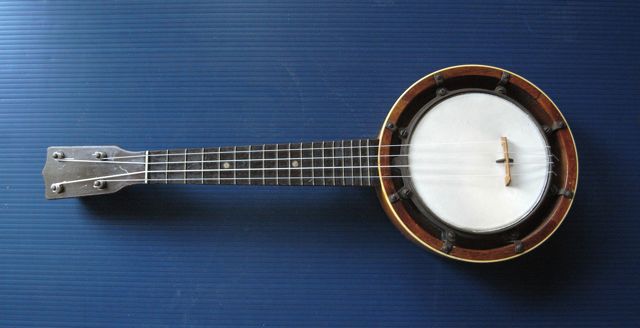
This another uke with a 5 1/2" pot even though the uke is 7 3/4" wide. The uke has heavy metal parts inside the wood and is extremely loud but the tone is unpleasantly thin. It might sound better if the vellum used were heavy weight instead of medium weight.
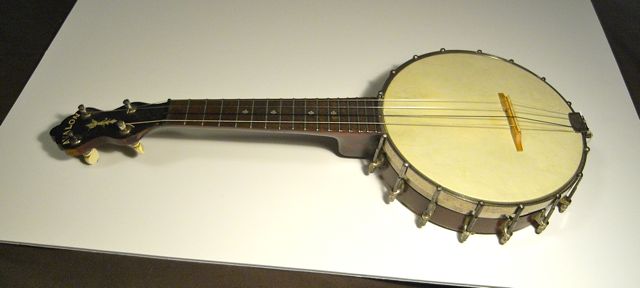
.This is an "Avalon" banjo ukulele sold under other names also and the company that made these is unknown to me. It has an 8" head surrounded by a very heavy tone ring which gives it a full rich sound. These under whatever name is on them usually go for well over $200.00 often over $250.00. The tension ring is so thick that it has a groove in it for the ends of the hooks that hold it in place.
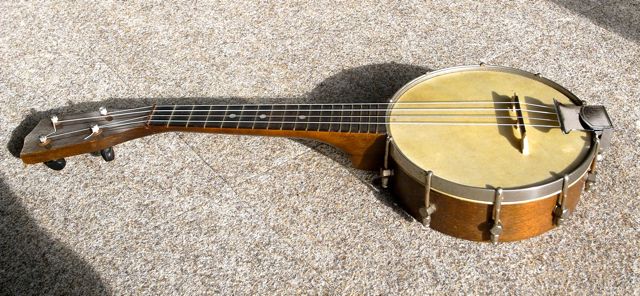
This is "Standard Approved" banjo ukulele which means that it was sold by Sears Roebuck but the company that made it is not known. It is fairly heavy and the sound is crisp and fairly loud. The neck is a little narrow, a minor problem. The tailpiece is not original. Here is a video of Katy Carr (from England) playing a uke somewhat like this one.
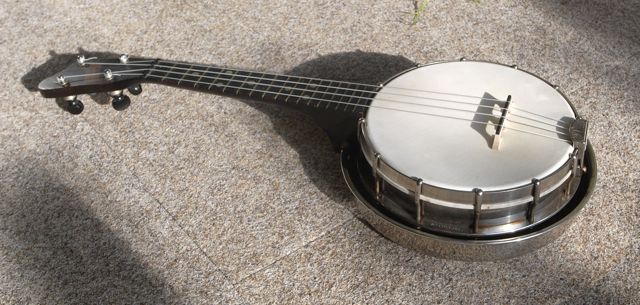
This is an all-metal banjo ukulele (except the neck), marked "Banjo-ette Elkhart, USA" but the same model was sold under several other names including "Bruno Maxitone U-King" and "Jollie-Joe". The resonator resembles an aluminum frying pan. This uke was usually sold without the resonator and sounds good that way also. The diameter of the pot is 7" which I think is about the minimum for good sound. This uke sounds a little better than the 7" May Bell probably because of its construction from heavy aluminum instead of wood. Watch this video of "Nickelodeon" which features a uke like the one above. Here is a video clip of the Maxitone U-King (Banjo-ette) being played. The tone is a little metallic but good and also loud. The vellum is not original and was installed by yours truly by the method shown on the Repair Gallery of this website.
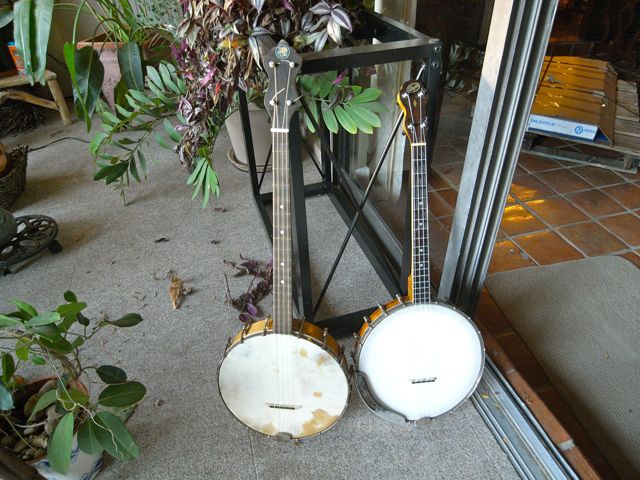
Pictured above are open-back tenor banjos which are tuned the same as a baritone ukulele. The one on the left is the common 19-fret type strung with real gut strings made for a 5-string banjo (minus the short 5th string.) The banjo on the right is a 17-fret model which has a shorter neck giving a scale length about the same as on a baritone ukulele. It is strung with Nylgut classic banjo strings which are made from a special type of nylon and are easier to find than real gut strings and which also sound great. La Bella makes a set of nylon banjo strings which have low tension when used on a 17-fret tenor banjo and you can play them with your fingers like you play your ukulele (which is also the case with the Nylgut and the natural gut strings.) With the banjo tuned like a baritone ukulele, you can use the guitar-chord diagrams until you have the chords memorized. Tenor banjos have either 17 or 19 frets and can be had open backed or with a resonator. The loud ones are as loud as the brass instruments in the band. Because the neck is so long it is possible to play way up the neck thus allowing an extended tonal range not found on other ukulele-type instruments. Although the length of the scale on the 17-fret tenor banjo is about the same as on a baritone ukulele, the neck is much narrower. Now days many if not most tenor banjo players use "Chicago" or "guitar" tuning: D G B E like the highest 4 strings of a guitar and the same way a baritone ukulele is tuned. If your E string breaks, you can use 25 lb nylon fishing line available at Academy which is stronger. Listen to the Firehouse Five Plus Two to hear how the banjo sounds when it is tuned this way.
This link to the Ukulele Underground has a discusion of ukulele banjo vs. tenor banjo. To hear a short-neck tenor banjo strung with nylon strings and tuned like a baritone ukulele, listen to "Rag Moma Rag" played by the Jug Band on youtube.com.
|